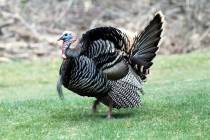Meaty collared doves don’t count toward bag limit
For the past couple of years, dove hunters have reported seeing a bird that resembles a mourning dove but is bigger and lighter in color. Some have seen the bird on the wing and chosen not to shoot, and others have shot the birds and simply counted them as part of their daily bag.
You wouldn't be wrong with either choice, but you don't have to count them as part of your bag limit. Not in Nevada, anyway.
The bird I am describing is, in fact, a dove, the Eurasian Collared Dove. It is easy to identify by the black band or half-collar on the back of its neck and its sandy gray body. The collared dove easily dwarfs the average mourning dove. On the wing, the two birds are quite different as well. Mourning doves have a long diamond-shaped tail, and the collared dove has a square tail. And while mourning doves are known for their quick acrobatic maneuvers, the collared dove utilizes a more relaxed, even flight path.
Collared doves were introduced in the Bahamas in the 1970s and eventually made their way to the United States, where they have thrived in human environs and moved westward. These birds are unprotected and may be harvested by hunters in the field.
Because they are unprotected in Nevada, you do not have to count them as part of your bag, but I recommend that you keep the head and a wing attached until you get home. This can keep you out of trouble and make identification easy if you get checked by a game warden. One hunter I spoke with said collared doves eat well and offer a lighter meat than mourning doves, not to mention more of it.
■ APPRENTICE LICENSES -- If you are planning to hunt the dove opener next week, why not take a friend or family member along for a test ride?
Nevada has a new hunting license that will permit new hunters to do just that. It's called the Apprentice Hunter License.
The license is intended to give new hunters -- those who are 12 and older and have never been issued a hunting license in Nevada or elsewhere -- the chance to experience hunting without having to meet state Hunter Education requirements before doing so.
Apprentice hunters can hunt upland game and waterfowl for one season, but their apprentice license does not apply to big game hunting. To qualify for an apprentice license, a person must have a mentor who will personally supervise them whenever they are in the field hunting. The mentor must be at least 18, have a valid Nevada hunting license and be willing to assume legal responsibility for the apprentice. Legislation creating the license was passed during the 2009 legislative session.
Nevada's Apprentice Hunter License is free, but buyers must pay mandatory conservation and license agent fees totaling $4. They also need to buy any required stamps, such as the upland game bird stamp ($10) or state and federal waterfowl stamps ($10 and $16). The Apprentice Hunter License is available at NDOW regional offices, though online purchases will be available in the future.
Freelance writer Doug Nielsen is a conservation educator for the Nevada Department of Wildlife. His "In the Outdoors" column, published Thursday in the Las Vegas Review-Journal, is not affiliated with or endorsed by the NDOW. Any opinions he states in his column are his own. He can be reached at intheoutdoorslv@gmail.com.

















